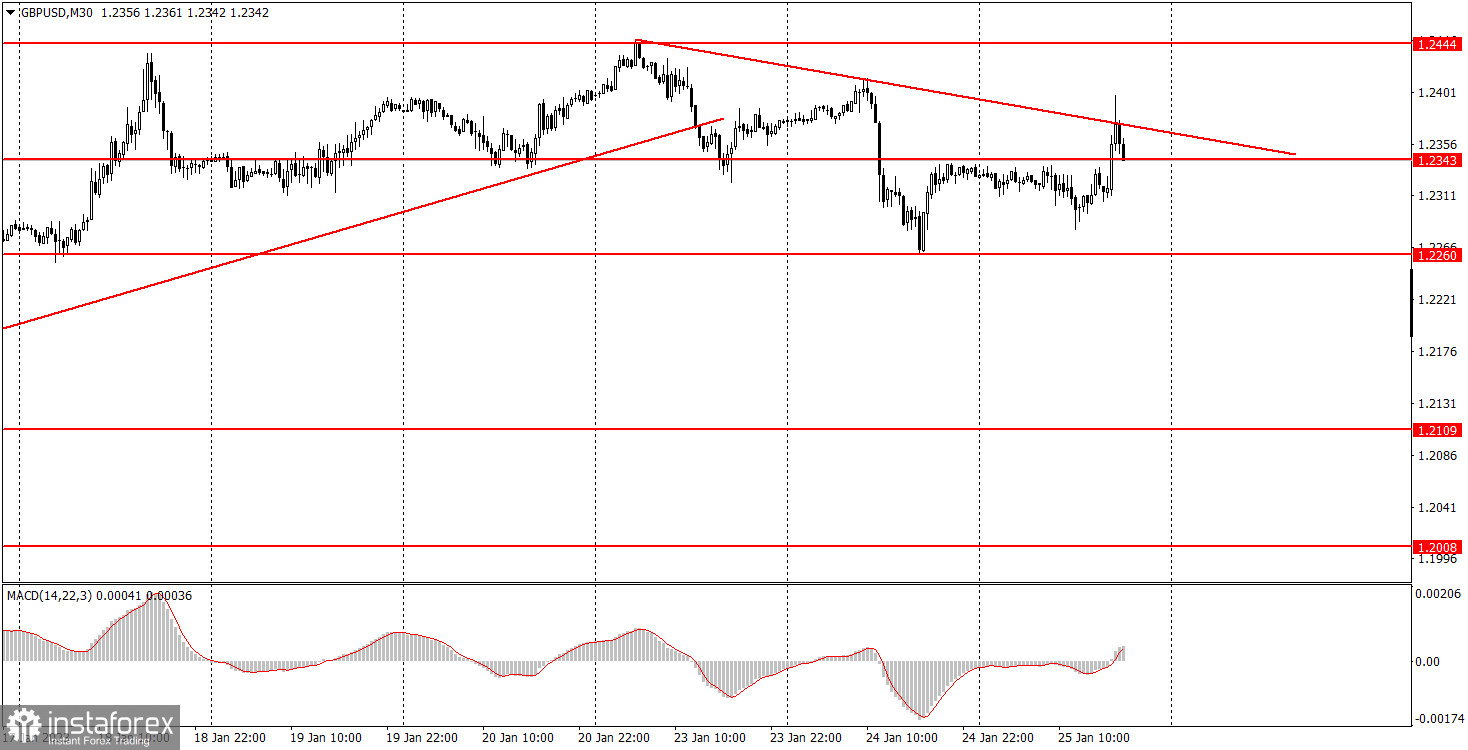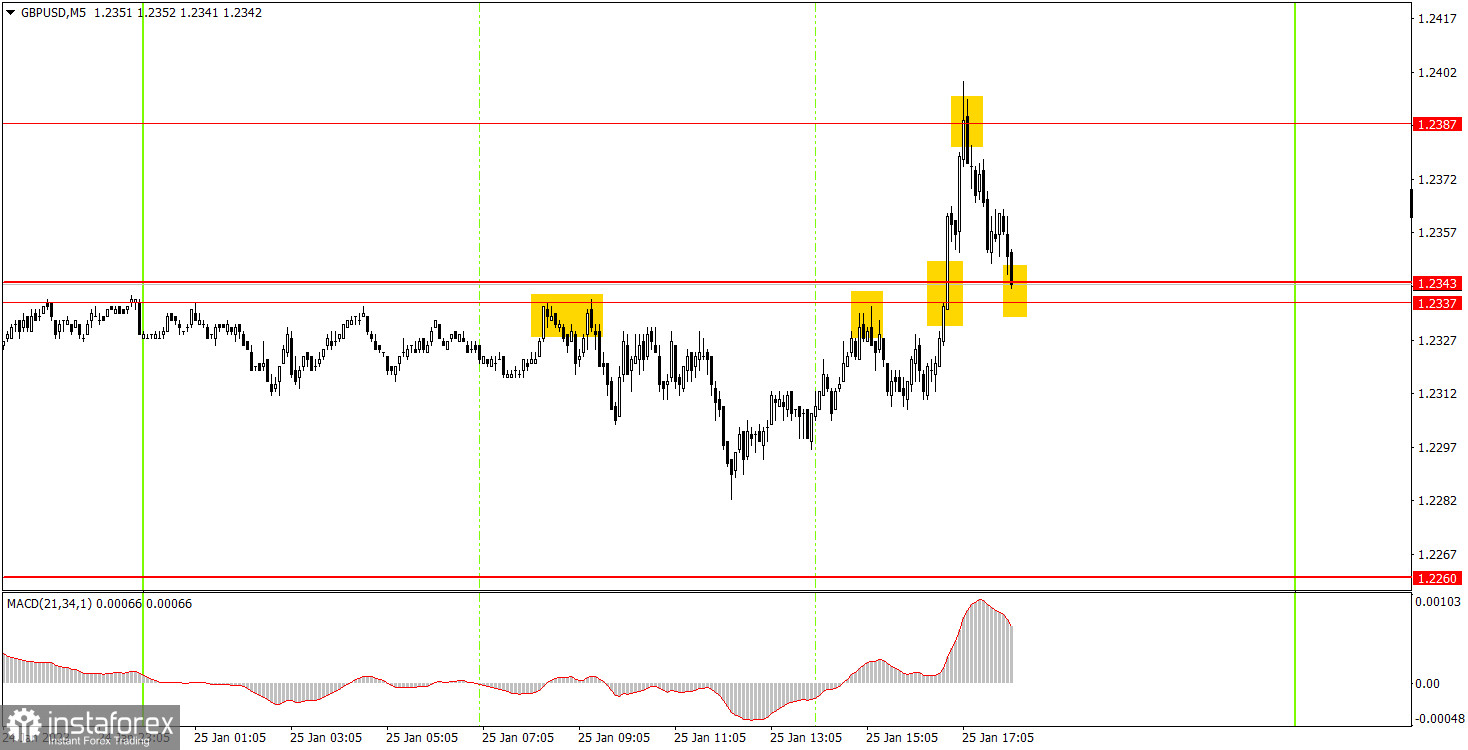Analyzing Wednesday's trades:
GBP/USD on 30M chart

GBP/USD edged up on Wednesday, but volatility was generally not very high. Throughout the day, traders could only pay attention to the UK producer price index. However, this report did not provoke any reaction since it isn't important. During the European session, the pair was moving sideways instead of moving in a trend. Nevertheless, the movements of the last few days made it possible for us to form a new descending trend line, which currently supports the bears. A rebound from it suggests that a new round of decline will start on Thursday. Do recall that we have been waiting for the pair to fall for a long time now, since there aren't any clear reasons for the pound to continue rising after it went up by more than 2000 points already, which is about 50% of the entire global downtrend, which has been observed for the last two years. Nevertheless, a consolidation above the trend line could again trigger a groundless rise of the British currency.
GBP/USD on M5 chart

Speaking of trading signals, the situation was not the best, but we should still try to figure out how we should have traded. The first two signals - the bounces from 1.2337 - were false, because the pair could not reach the nearest target level. To be fair, it should be mentioned that it was located far enough. In the first case, the price moved 40 pips in the right direction, while in the second case, it reached 16 pips. In the first case, a Stop Loss broke even, in the second case, there was a small loss when the price was above the area of 1.2337-1.2343. The buy signal near this area should not have been triggered, since the last two signals were false and the corresponding positions were opened. But the rebound from 1.2387 could be covered by a short position, which allowed newcomers to earn about 27 pips, as the price quickly went back to 1.2337-1.2343. As a result, the loss on the second deal was evened out.
Trading tips on Thursday:
On the 30-minute chart, GBP/USD still tries to follow the technical signals and continues falling after crossing the trend line. However this decline is very forced, so bears need fundamental or macroeconomic support, which there are few of. On the 5-minute chart, it is recommended to trade at the levels 1.2109, 1.2171-1.2179, 1.2245-1.2260, 1.2337-1.2343, 1.2387, 1.2444-1.2471, 1.2577-1.2597. As soon as the price passes 20 pips in the right direction, you should set a Stop Loss to breakeven. There are no interesting events scheduled for Thursday in the UK, while the U.S. will release its fourth quarter GDP report and durable goods data. These reports look very important on the surface, but in practice, traders often react softly to them.
Basic rules of the trading system:
1) The strength of the signal is determined by the time it took the signal to form (a rebound or a breakout of the level). The quicker it is formed, the stronger the signal is.
2) If two or more positions were opened near a certain level based on a false signal (which did not trigger a Take Profit or test the nearest target level), then all subsequent signals at this level should be ignored.
3) When trading flat, a pair can form multiple false signals or not form them at all. In any case, it is better to stop trading at the first sign of a flat movement.
4) Trades should be opened in the period between the start of the European session and the middle of the US trading hours when all positions must be closed manually.
5) You can trade using signals from the MACD indicator on the 30-minute time frame only amid strong volatility and a clear trend that should be confirmed by a trendline or a trend channel.
6) If two levels are located too close to each other (from 5 to 15 pips), they should be considered support and resistance levels.
On the chart:
Support and Resistance levels are the levels that serve as targets when buying or selling the pair. You can place Take Profit near these levels.
Red lines are channels or trend lines that display the current trend and show in which direction it is better to trade now.
The MACD indicator (14, 22, and 3) consists of a histogram and a signal line. When they cross, this is a signal to enter the market. It is recommended to use this indicator in combination with trend patterns (channels and trendlines).
Important announcements and economic reports that can be found on the economic calendar can seriously influence the trajectory of a currency pair. Therefore, at the time of their release, we recommend trading as carefully as possible or exiting the market in order to avoid sharp price fluctuations.
Beginners on Forex should remember that not every single trade has to be profitable. The development of a clear strategy and money management is the key to success in trading over a long period of time.
 English
English 
 Русский
Русский Bahasa Indonesia
Bahasa Indonesia Bahasa Malay
Bahasa Malay ไทย
ไทย Español
Español Deutsch
Deutsch Български
Български Français
Français Tiếng Việt
Tiếng Việt 中文
中文 বাংলা
বাংলা हिन्दी
हिन्दी Čeština
Čeština Українська
Українська Română
Română

